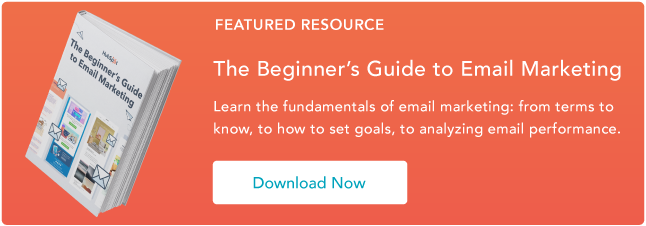One of the first things I do every day is check my email. And I'm not the only one.
Did you know that roughly 80% of marketers have reported an increase in email engagement in 2020?
And that the number of global email users is set to grow to 4.48 billion users by 2024?
Additionally, email marketing has the highest return on investment for small businesses and is the second most effective medium for building brand awareness.
Wow. Those stats alone serve as a reminder that email marketing is not a thing of the past. It's continuing to grow and is a major way that brands learn about and engage with their customers.
As the adage goes, email marketing is about sending the right message to the right people at the right time.
But, how do you do that?
In this post, let's review the top strategies you can use to get to know your email subscribers according to research.
1. Use analytics.
A great way to learn about your current email subscribers is to dive into your analytics. Find out what emails perform best. Is there a pattern? What topics is your audience most interested in?
What emails do they engage with the most? What day/time are your open rates higher?
Analytics can help you figure all of this out so you can be in touch with and provide content that your audience wants.
Cynthia Price at Litmus says, "If emails could talk, you could learn a lot about your subscribers. Oh, wait. They do. Open rates, click-through rates, and other standard email metrics all give you signals. They're interested. They're not. They're done."
But how do you optimize other things like templates? Or apply what you learn in your email program to other channels?
Price explains, "With analytics that go beyond opens and clicks. When you know which email clients your subscribers use, you can optimize the experience for them. For example, what if the majority of your subscribers are on mobile and using Dark Mode? You'll want to incorporate that into your design strategy and QA & testing process. Or let's say you know an email has a high forward or print rate. You might have a possible viral piece of content on your hands. Don't miss out on insights like these—see what your subscribers are telling you."
Ultimately, monitoring your metrics will help you identify what your audience is interested in.
2. Participate in social media listening.
Did you know that 37% of consumers find purchase inspiration from their social media channels?
Paying attention to what your audience is doing on social media will help you learn more about your consumers so you can understand the content that they want to see.
Think, "What are they interacting with on social media? What type of information are they looking for?"
With this information, you can learn what content your audience really enjoys.
3. Send polls.
This might seem a little too straightforward, but honestly, the best way to learn about someone is to ask them questions.
Send out polls in your emails and learn about your audience.
For HubSpot's Service Blog, the daily email newsletter includes a question of the day. This helps us learn more about our audience on a regular basis.
4. Conduct A/B testing.
A/B testing is one of the most reliable ways to learn what type of email content your email subscribers react well to.
In fact, companies that A/B test every email see email marketing returns that are 37% higher than those of brands that never include A/B tests.
You can use A/B testing to see what types of subject lines work best, what type of email copy, and more.
Price says, "You can optimize content by A/B testing like 90% of marketers. Or personalize to deepen engagement. Birthday emails are said to get 3.42 times the revenue of a standard promotional email."
5. Segment your lists.
Segmenting your email list when you learn more information about your audience will help you send better, personalized emails.
Emails that have personalized subject lines are 26% more likely to be opened and marketers have found a 760% increase in email revenue from segmented campaigns.
Essentially, email segmentation can help you increase open rates and improve click-through rates.
When you go to segment your list, segment by how people found your page. What were they signing up for? For instance, someone who purchased a product and someone who downloaded a specific lead magnet will be interested in different email newsletters.
You might segment your list by people who want to learn about blog posts and those who are interested in sales information.
Additionally, you can segment by location. Or maybe even open rate -- send emails to your most engaged subscribers.
This will help you send the right emails to the right people.
6. Do buyer persona research.
If you don't have a buyer persona, you might consider creating one. This will help you understand your subscriber's problems, goals, challenges, values, demographic information, and more.
Conducting buyer persona research will mean that you'll interview customers and learn about their preferences. Then, create a fictionalized version of your customers based on real data. This is another reason why it's so important to use your analytics to learn more about your subscribers.
7. Try new things.
Getting to know your email subscribers can be a fun way to experiment with email marketing. Try new things and see what your audience responds to. You can try different types of content, different rich media, or different subject lines.
With email marketing on the rise, it's important to optimize your strategies. You need to really know your email subscribers to reap the benefits of email marketing.
How to Get to Know Your Email Subscribers, According to Research was originally posted by Local Sign Company Irvine, Ca. https://goo.gl/4NmUQV https://goo.gl/bQ1zHR http://www.pearltrees.com/anaheimsigns
![→ Download Now: The Beginner's Guide to Email Marketing [Free Ebook]](https://no-cache.hubspot.com/cta/default/53/53e8428a-29a5-4225-a6ea-bca8ef991c19.png)

No comments:
Post a Comment